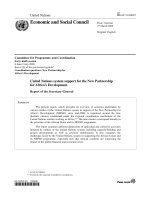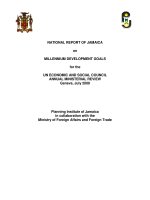Case Study: chinas plan for national economic and social development
Bạn đang xem bản rút gọn của tài liệu. Xem và tải ngay bản đầy đủ của tài liệu tại đây (228.5 KB, 3 trang )
Low Carbon Green Growth Roadmap for Asia and the Pacific
CASE STUDY
Shifting from quantity to quality of growth
China’s Plan for National Economic and Social Development
Key point
•
China’s Twelfth Five-Year Plan for National Economic and Social Development (2011–2015) is a good
example of how a country’s national development plan can incorporate low-carbon growth strategies –
achieving low-carbon goals as an engine for pursuing economic growth.
What was done?1
The Twelfth Five-Year Plan was formed by the National Development and Reform Commission (NDRC) and
endorsed by the National People’s Congress in March 2011. The NDRC is implementing the plan and monitoring
the progress.
In comparison with the previous Five-Year Plan, the current plan has made a dramatic shift from pursuing only
greater economic growth to pursuing higher quality of growth that tackles growing concerns over the increasing
income disparities within the population and among regions and providing better social and welfare services
and a better living environment. One of the new features of the Plan is the concept of “inclusive growth.”2
The plan places more emphasis on tackling and improving various environmental issues, such as climate
change, pollution and energy security. It also stresses strengthening the associated industrial sectors as the foundations for pursuing further growth, which is why it is characterized as a green or low carbon development plan.
The Government has committed to the concept of low carbon green growth by establishing targets to improve
energy consumption and reduce carbon emissions and the share of fossil fuel supply. In addition, new energy
(nuclear, wind and solar), energy conservation and environmental protection, biotechnology, new materials
(rare earths and high-end semiconductors), next-generation information technology, high-end equipment
manufacturing (aerospace and telecom equipment) and clean energy vehicles have been designated as the
plan’s seven strategic industrial sectors.3 These new sectors will be strengthened through industrial policy interventions and support for R&D efforts and technological innovations.
The Government has set annual targets through yearly government work reports that feed into achieving the
targets and goals of the Five-Year Plan. Sector-based, provincial and city-level plans that reflect the national
goals and targets of the Five-Year Plan are being developed. In addition, the targets that were set from 20112015 in the Five-Year Plan are interim targets that feed into longer-term targets, such as the reduction of carbon
intensity by 40-45 per cent by 2020.
The Five-Year Plan’s environment-related targets cover:
Climate and energy targets
•
Reduce 16 per cent in energy consumption per unit of GDP from 2010 levels by 2015 (energy intensity)
•
Reduce 17 per cent in CO2 emissions per unit of GDP from 2010 levels by 2015 (carbon intensity)
•
Non-fossil fuel to account for 11.4 per cent of the primary energy consumption from 2010 levels by 2015.
1
Shasha Deng, “Key Targets of China’s Twelfth Five-Year Plan”, Xinhua, March 5, 2011. Available from
(accessed 1 September 2011).
2 KPMG China, China’s Twelfth Five-Year Plan: Overview (Beijing, 2011). Available from
www.kpmg.com/cn/en/IssuesAndInsights/ArticlesPublications/Documents/China-12th-Five-Year-Plan-Overview-201104.pdf (accessed 1
September 2011).
3
ibid.
Low Carbon Green Growth Roadmap for Asia and the Pacific :
Case Study - China’s Plan for National Economic and Social Development
Forestry targets
•
Increase forest coverage rate to rise to 21.66 per cent and forest stock to increase to 600 million cubic
metres.
Water targets
•
Reduce water consumption per unit of value-added industrial output by 30 per cent.
Science and technology targets
•
Expenditure on R&D to account for 2.2 per cent GDP
•
Increase the number of patents to 3.3 patents per 10,000 inhabitants by 2015.4
Pollution targets5
•
Reduce chemical oxygen demand and sulphur dioxide (SO2) by 8 per cent each
•
Reduce nitrogen oxide and ammonia nitrogen by 10 per cent each
•
Motor vehicle emissions standards for cities.
Climate change related6
•
Inventory- improved system for monitoring greenhouse gas emissions
•
Gradually introduce the establishing a carbon trade market.
Energy efficiency7
•
Promote energy efficiency in industry and in new as well as in existing buildings
•
A new programme under the introduction of 1,000 Enterprise Programme.
Industry8
•
Develop seven priority industries contributing to economic growth, such as energy saving and
environmental protection, new energy and clean energy vehicles.
Transport9
•
35,000 km of high-speed rail that connects cities with populations over 500,000
•
Improve subway and light rail coverage in cities with existing transportation systems, build new systems in
at least nine cities and make plans for at least six cities.
Circular economy
•
Promote waste water and solid waste treatment
•
Promote reuse and recycle.
The great challenge for China now will be achieving the ambitious goals and targets. The Government has demonstrated that with political commitment from the highest level, national plan and a systematic way of implementing policies nationwide (from the national to local levels) it can move to a low carbon development path.
4
The number of invention patents per 10,000 inhabitants here refers to the granted domestic patents, not the total. It indicates the patent
values and nation’s market controlling capacity. State Intellectual Property Office of China, “What is the meaning of ‘3.3’?”, 13 May, 2011
[in Chinese]. Available from www.sipo.gov.cn/mtjj/2011/201105/t20110513_604228.html (accessed 1 March 2012).
5
KPMG China, China’s Twelfth Five-Year Plan: Overview (Beijing, 2011). Available from
www.kpmg.com/cn/en/IssuesAndInsights/ArticlesPublications/Documents/China-12th-Five-Year-Plan-Overview-201104.pdf (accessed 1
September 2011).
6 Joanna Lewis, Energy and Climate Goals of China’s Twelfth Five Year Plan (Arlington, V.A., Center for Climate and Energy Solutions,
2011). Available from www.pewclimate.org/docUploads/energy-climate-goals-china-twelfth-five-year-plan.pdf (accessed 1 September
2011).
7
D. Seligsohn and A. Hsu, “How Does China’s 12 Year Five-Year Plan Address Energy and the Environment?”, News of Climate, Energy &
Transport, World Resource Institute, March 7, 2011. Available from www.wri.org/stories/2011/03/how-does-chinas-12th-five-yearplan-address-energy-and-environment (accessed 1 September 2011).
8
KPMG China, China’s Twelfth Five-Year Plan: Overview (Beijing, 2011). Available from
www.kpmg.com/cn/en/IssuesAndInsights/ArticlesPublications/Documents/China-12th-Five-Year-Plan-Overview-201104.pdf (accessed 1
September 2011).
9
D. Seligsohn and A. Hsu, “How Does China’s 12 Year Five-Year Plan Address Energy and the Environment?”, News of Climate, Energy &
Transport, World Resource Institute, March 7, 2011. Available from www.wri.org/stories/2011/03/how-does-chinas-12th-five-yearplan-address-energy-and-environment (accessed 1 September 2011).
Low Carbon Green Growth Roadmap for Asia and the Pacific :
Case Study - China’s Plan for National Economic and Social Development
Considerations for replicating
Achieving goals and targets requires supplementing how-to plans. For example, to better implement the Twelfth
Five-Year Plan’s goals and targets for reducing energy consumption and carbon emissions, the national and
provincial governments and industry administrators will also adopt special plans and measures, such as the Nonferrous Twelfth Five-Year Special Plan, the Industrial Transformation and Upgrading Special Plan (2011–2015), the
Twelfth Five-Year Plan of Jiangxi Province and Information and Industry Development Plan in Jiangxi Province
(2011–2015). A monitoring and review process is required at all levels of government and of different organizations in the form of periodic assessment reports.10 Based on the assessments, the Government will set or modify
annual targets. The Government will also introduce various measures and programmes to incentivize the public
and local authorities to help fulfil the goals and targets.
10
APCO Worldwide, China‘s 12th Five-Year Plan: How it actually works and what‘s in store for the next five years (Beijing, 2010). Available
from www.apcoworldwide.com/content/pdfs/chinas_12th_five-year_plan.pdf (accessed 1 March 2012).









